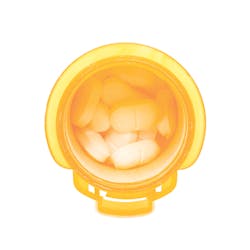Alternatives to dental opioids
Effective options for relieving patients’ dental pain
Amber Metro-Sanchez, BA, RDH
Have you ever had a patient with a toothache tell you specifically that he or she does not want a prescription for painkillers? Are you aware of the alternatives that are available to help your patients when they have true dental pain and need a reliable method to manage it? Do you know how effective these alternatives are at relieving dental pain?
Opioids have been all over the news lately as the potential for addiction is a growing concern. You may have heard stories of an “everyday” person receiving a prescription for painkillers while recovering from an injury or surgery, and then unintentionally becoming addicted. You may even know someone experiencing this situation and find it quite difficult to believe that he or she became addicted.
As of 2015, two million Americans aged 12 and older had a substance use disorder involving prescription painkillers.1 The deaths attributable to opioids increased by nearly 300% from 2001 to 2016, according to a study recently published by the Journal of the American Medical Association.2 Shockingly, 2016 figures show that, among adults aged 24 to 35, opioids were involved as a cause of death 20% of the time.
Unfortunately, dentistry has played a role in this growing opioid epidemic, albeit unintentionally. There has always been a delicate balance between treating dental pain, which at times can be quite severe, while recognizing the underlying potential for addiction. When I began working as a dental hygienist, it was standard practice to prescribe opioids for toothaches, and it was something I never questioned at the time. The focus was placed mainly on managing dental pain, as prescription opioid addiction was not a common problem yet.
© Mtsaride - Dreamstime.com
It is quite possible that dentists as a group did not realize how many prescriptions for painkillers were being provided during that time. According to a study published in the Journal of the American Medical Association in 2011, dentists were the number one prescriber of opioids for patients 10 to 19 years of age, accounting for 30.8% of prescriptions.3 And, of course, this is the age when people are getting their wisdom teeth out. Overall, this study showed that 8% of the prescriptions for opioids across all age groups in the study were provided by dentists.
In March 2018, the American Dental Association released a new policy to combat opioid addiction.4 It consists of three components to help dentistry make a dent in the opioid epidemic. The first recommendation supports mandatory continuing education on the prescribing of opioids and other controlled substances. The next guideline supports statutory limits on opioid dosages and a maximum duration of seven days for the management of acute pain. Finally, the last component supports dentists utilizing prescription drug monitoring programs. By using these systems, practices are more easily able to identify patients seeking treatment from multiple practitioners, and as a result, deter the further misuse and abuse of opioids.
A next critical step to preventing the future abuse of opioids is to move away from their utilization as much as possible while still providing patients with adequate pain relief. There are several excellent medications that are effective alternatives, although they may not be known to many dental professionals yet.
Nasal sprays
Sprix (ketorolac tromethamine) is an opioid alternative that holds much promise for the future. It is the only intranasal nonsteroidal anti-inflammatory drug (NSAID) that provides pain relief at the opioid level.5 It is indicated for the short-term (up to five days) management of moderate to moderately severe pain in adults who require pain analgesia at the opioid level. This drug is ideal for patients who have pain due to extractions, root canals, implant placement, or periodontal surgery.
Sprix is dispensed as five color-coded bottles, with one bottle to be used per day. This medication is rapidly absorbed through nasal mucosa and provides pain relief for six to eight hours, reaching its maximum plasma concentration in 45 minutes. Sprix is not inhaled, but simply sprayed into the back of the nostril while the head is tilted downward. For adults under 65 years of age with normal renal function and weighing over 110 pounds, one spray is indicated every six to eight hours in each nostril. For adults 65 years of age or older, or those with impaired renal function and/or weighing less than 110 pounds, only one spray in one nostril is recommended.
Sprix is contraindicated for patients with peptic ulcer disease or gastrointestinal bleeding. There also is a risk for serious bleeding events if the patient is already taking blood thinners, selective serotonin reuptake inhibitors, or selective norepinephrine reuptake inhibitors. People with allergies to an NSAID should not use this product either.
Long-lasting local anesthetics
One common downfall of pain medications is that they have a limited duration of action and, as a result, patients will experience an increase in pain before the next dose kicks in. Exparel is a new nonopioid pain management option that provides consistent pain relief and avoids this problem altogether.6 It is an injectable, long-lasting anesthetic that is composed of bupivacaine suspended in liposomes to ensure its slow and continual release with pain relief that lasts up to 96 hours. It is ideal for wisdom teeth extraction as it is designed to deliver postsurgical pain relief in the days following surgery, when pain is at its worst.
Exparel is administered via infiltration rather than nerve block. All areas of the surgical site are infiltrated repeatedly. For example, if a patient has all four wisdom teeth removed, 10 ml of Exparel is recommended for pain management. An amount of 3 ml is administered to the soft tissue surrounding each extraction site for teeth Nos. 17 and 32. Next, 2 ml of anesthetic is injected into the soft tissue areas surrounding Nos. 1 and 16.
There are a few rules to follow when it comes to using Exparel and other local anesthetics during the same procedure. A
nonbupivacaine local anesthetic can be used in the same surgical site when there is a time separation of at least 20 minutes. Otherwise, if the administration sites differ, there are no potential issues. For example, if a nerve block is provided with lidocaine to provide immediate pain relief, then the surgical site can be infiltrated with Exparel to give extended pain relief. As far as bupivacaine goes, it can be used at the same site as long as the ratio of bupivacaine to Exparel does not exceed 1:2.
Some insurance companies, such as Aetna, have begun reimbursing for the use of Exparel.7 The aim is to responsibly minimize the prescribing of opioids in the United States. Mary Lee Conicella, the chief dental officer at Aetna, has stated that “our goal is to make an opioid-free third molar experience available to all patients.”7
Combining conventional NSAIDs
One readily available alternative to opioid use is administering ibuprofen in combination with acetaminophen. According to an article published by the Journal of the American Dental Association, this method provided the highest proportion of adult patients with greatest amount of pain relief.8 The optimal combination included 400 mg ibuprofen and 1,000 mg acetaminophen, resulting in at least 50% pain relief for a median length of eight hours. This same study showed that medications containing opioids and opioid combinations experienced the highest frequency of adverse events, further detracting from their usage.8
With a variety of opioid alternatives available, there is hope for a future in which opioid addiction can be prevented for patients suffering from acute pain—and both you and your dental office can play a part in making that happen. Too many lives have been ravaged by the cruel curse of addiction, and a positive change can be made by greatly reducing the use of opioids. In dentistry, many effective alternatives for pain control exist, and it’s just a matter of time before we all start taking full advantage of them.
References
1. Opioid Addiction: 2016 Facts and Figures. American Society of Addiction Medicine website. https://www.asam.org/docs/default-source/advocacy/opioid-addiction-disease-facts-figures.pdf.
2. Gomes T, Tadrous M, Mamdani M, et al. The burden of opioid-related mortality in the United States. JAMA Network Open. 2018;1(2);e180217.doi:10.1001/jamanetworkopen.2018.0217.
3. Volkow ND, McLellan TA, Cotto JH, Karithanom M, Weiss SR. Characteristics of opioid prescriptions in 2009. JAMA. 2011;305(13):1299-1301 doi:10.1001/jama.2011.401.
4. American Dental Association announces new policy to combat opioid epidemic. American Dental Association [news release]. American Dental Association Media Relations; March 26, 2018. https://www.ada.org/en/press-room/news-releases/2018-archives/march/american-dental-association-announces-new-policy-to-combat-opioid-epidemic
5. Home page. Sprix website. https://www.sprix.com/
6. Infiltration technique: Sprix vs. local anesthetics. Exparel website. https://www.exparel.com/hcp/video/oral-maxillofacial/15
7. An alternative to opioids for wisdom teeth extraction. Aetna website. https://news.aetna.com/2017/11/alternative-opioids-for-wisdom-tooth-extractions/ Published November 13, 2017.
8. Moore P, Ziegler K, Lipman R, et al. Benefits and harms associated with analgesic medications used in the management of acute dental pain. J Am Dent Assoc. 2018;149(4):256-265.e3. doi:10.1016/j.adaj.2018.02.012.
Amber Metro-Sanchez, BA, RDH, practices dental hygiene with Chris Bible, DDS, at Comfort Dental in Fort Wayne, Indiana. She also works as a professional educator on behalf of Waterpik. Amber was a member of the 2015 Colgate Oral Health Advisory Board. She is also a contributing author for the Colgate Professional and Colgate Oral Care Center webpages. Reach her at [email protected].


